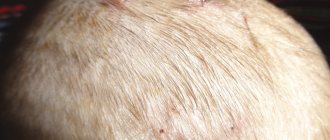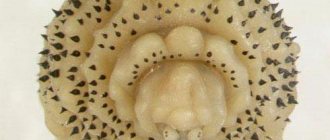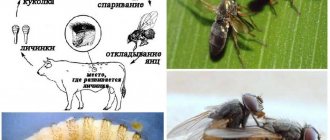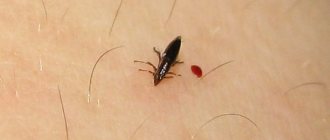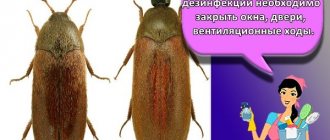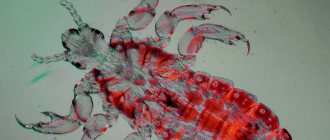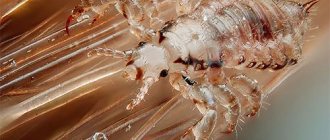The gadfly belongs to a family of insects that resembles flies in appearance. The main habitat is the tropics and subtropics; it can often be found in Russia. Insects lay eggs in the fur of animals, but they can also choose humans for this purpose. They do not pose a danger to people, but the gadfly larva can cause significant harm to the body. There are 150 species of insects in total, but only one of them is dangerous - the skin gadfly (Dermatobia hominis), which is capable of attacking people.
What is a gadfly larva?
After birth, the gadfly larva is quite small.
However, under the skin of a mammal it grows very quickly and after a couple of weeks can reach a length of 20 mm. Externally, the larva looks like a maggot. Only its body is pear-shaped with several transverse rows of spikes resembling hooks. She uses them to securely attach to the skin, hair or fur. The main food is blood.
The development cycle of a gadfly larva does not exceed 5 weeks on average. But having become an adult, it continues to parasitize the host for another 2-3 months, absorbing nutrients and receiving oxygen through a fistula formed in the epidermis. After which it tries to get out from under the skin to pupate.
Mating and flight
Mating occurs almost immediately after it emerges from the pupa. Scientists note that during this period, males live every year in the same place where they fly to mate. Next, fertilized females begin to actively search for future owners to breed offspring.
The laying method depends on the type of female insect:
- The line usually flies around a herd of animals, making characteristic sounds that frighten them. Having chosen a host, she lays one egg on each hair;
- The female esophagus has a different strategy: she sneaks up on the prey unnoticed, making short flights or crawling, then quickly lays 5-20 eggs per hair.
The number of eggs in the female’s abdomen can reach 700, each of which will subsequently hatch into a larva that will gnaw on its prey. Thanks to such high fertility, insects reproduce well even with a minimum number of adult individuals and their short lifespan. They have few enemies: among those who eat gadflies and other flies. and bugs - only birds.
The period of flight and mating of gadflies occurs depending on the climatic zone of habitat: in the southern regions it is longer, in the northern regions it is shorter.
How can a larva enter the body?
An adult gadfly is a fly whose size does not exceed 18 mm. It has a large head with large eyes located on it, a blue belly, orange-colored legs and transparent wings. Because of the hairs all over its body, the gadfly resembles a bumblebee.
An adult insect does not feed on anything throughout its short life, but uses the nutrients accumulated in the larval phase.
30 seconds after emergence, an adult gadfly becomes capable of flight and reproduction. One female can produce up to 700 eggs, but the larva emerges from only 1/5 of them.
The female catches mosquitoes, ticks and almost 40 species of other blood-sucking insects and lays eggs on their abdomens. At the moment when insects land on human skin, the larvae, sensing warmth, hatch from the eggs and move onto the skin, into which they are subsequently embedded. Penetration into the body is not accompanied by any painful sensations, and most often goes unnoticed by the person. Mature larvae have special hooks on their bodies with which they are able to cling to the skin. Feeding on blood, the larvae grow, eventually reaching 1.5-2 cm. In total, the parasite lives in the host’s body from 5 to 10 weeks. After this period, they crawl to the surface of the skin and fall to the ground, where they pupate. After 2-4 weeks, an adult human gadfly emerges.
About maggots
We most often suffer from flies in the summer, in August and July. They begin to multiply.
About the appearance of an insect
Fly development:
- Eggs. These insects are prolific. A fly can lay up to 150 eggs at once. Flies hide them where there is a lot of garbage and manure, and it is humid. But the female can choose another place for them: kitchen waste, meat and fish, rotten vegetables.
- Larvae. After 8 hours or a day, a larva hatches from the egg, the same maggot. She remains in this environment and eats spoiled food. In the larval stage, the insect lives from 5 days to 2 weeks.
- Doll. The maggot matures and the larvae begin to pupate. This takes 3 or 4 weeks. First, the insect moves to a dry place where it becomes a pupa.
- Fly. Their pupae are hatched by a fly that lives for only a month. But even during this time, one insect (female) lays from 500 to 2 thousand eggs. And the process of development of the fly begins again.
Why are fly larvae dangerous?
Why is it so important to fight fly larvae, why are they dangerous? These insects are carriers of pathogens of many intestinal diseases. But that's not all
If you buy meat and fish at the market, where they are not stored in the freezer, green flies will lay eggs in them. Larvae emerge from them. If you eat 1̶ 2 maggots along with these products, nothing bad will happen, although it is unpleasant. They will leave the body.
As soon as you leave fresh meat unattended, flies immediately “sprinkle” it
But if a person has swallowed a lot of insects, then his health will deteriorate sharply: his stomach will hurt, he will feel sick, vomiting, diarrhea will appear, and he will suffer from itching. Doctors advise taking a saline laxative immediately. Maggots are not that dangerous for humans. But those who vacation in Brazil, Mexico, Africa should be afraid of local flies; their larvae live in the human body and eat it. Therefore, in the tropics you cannot run barefoot, dry clothes under trees, and you must constantly use repellents.
Which gadflies lay eggs under human skin?
In Europe, Russia and Asia you can find about 10 species of gadflies (although there are more than 100 of them in the world). All of them do not choose humans as the host for their future offspring. These insects typically lay eggs on cattle or horses. Although cases of infestation of dogs, sheep, cats, rabbits and pigs have also been reported.
But in nature there is a much more dangerous human skin gadfly - Dermatobia hominis . It lives in the regions:
- Central America;
- Mexico;
- Argentina;
- Chile;
- Costa Rica.
Does this insect bite? No, but its eggs can penetrate humans, where they then turn into parasitic larvae under the influence of heat.
Once in the body, they develop quite quickly. At the same time, their penetration into the body causes inflammation, irritation of the skin, fever, and sometimes vomiting. But the greatest danger occurs when Dermatobia hominis larvae get into the head. Here they can migrate to the eye area. If the larva settles there under the mucous membrane, then there is a high probability of ophthalmomyasis, which in about half of the cases ends in loss of vision.
By the way, the larva of a gadfly can live in any part of the human body. Even under the skin on the skull. But most often these parasites choose the limbs, back and armpits.
How can you help a patient?
First, surgical treatment is performed. Then the patient is prescribed a course of antiparasitic medications with an antibacterial effect.
The duration of treatment depends on the degree of damage to the body. If there are a lot of larvae, then therapy lasts longer.
If a suspicious swelling is detected, proceed as follows:
- Rinse the problem area. The water should be cool. The use of any antibacterial soap is allowed. To ensure your safety, it is better to use baby soap.
- Apply a cool compress. This will help relieve itching and get rid of swelling. The compress can be soda or salt. 1 tsp dissolves in ½ glass of boiled water.
- You can disinfect the affected area by lubricating it with vodka, medical alcohol, or regular cologne.
- If the resulting lump is very itchy, you can take any antihistamine. The best medicines are Suprastin, Zodak, Tavegil. If there is a choice, then preference should be given to Suprastin, because Tavegil causes drowsiness.
How do botfly larvae enter the human body?
It turns out that not a single species of gadfly is capable of laying eggs directly into the human body. In addition, Dermatobia hominis on a continent far from us. So, there is no need to be afraid of him at all? Unfortunately no.
Cases of infestation by human gadfly larvae are found everywhere. Our country is no exception. Ask why? The fact is that they enter the body in another, more original way:
- The female gadfly quite often catches mosquitoes, ticks and several dozen species of other blood-sucking insects. Holding them with her paws, she diligently lays eggs on their bellies and backs.
- Then he releases them. As a result, after such “hugs,” insects become intermediaries in the process of human infection with larvae. After all, they fly further, land on people, bite them, and through the resulting wounds or cracks, the eggs of the gadfly get under the skin. There the larvae feel the warmth and awaken.
But that is not all. The larva can also penetrate by tactile contact from cattle. True, this usually happens in rural areas, on farms and pastures. It happens that parasites also enter the internal organs of a person. It is enough to eat improperly cooked, gadfly-infected meat.
For reference! Adult gadflies do not eat anything throughout their lives. They have enough of the substances that they accumulated when they were a larva.
Gadfly larva under skin
Differences in life activity and reproduction
It would seem that insects are similar in their goals, they bite painfully, and cause inconvenience with their intrusiveness, however, they also have many differences.
Difference between a gadfly and a horsefly:
| Gadfly | Horsefly |
| It has a bright color and is clearly visible. | Gray, camouflaged. |
| It can live everywhere - in forests, near water bodies, in the steppe, even in semi-deserts. | Lives mainly near bodies of water. |
| It does not drink blood, it bites in order to insert its larva into a living organism. | The female horsefly drinks blood in order to reproduce. |
| The subcutaneous type can remain under the skin for several months, gradually moving towards the back, closer to the spine. Lays larvae inside a living organism. | Lays eggs in the grass near water bodies. |
| Parasitizes the body of animals and humans. | Does not parasitize the body. |
The gadfly's task is to breed offspring. To do this, he uses ingenuity to deliver the eggs inside the animal or person.
There are several ways to enter:
- subcutaneous type - bites into the skin, penetrates inside. The goal is to place the eggs closer to the spine;
- A gadfly that places its larvae in the nasopharynx. Circling around the nose, near the nostrils of insects, places the eggs in the nasopharynx. There they grow, go through a gestation cycle, and then leave the body.
- The gastric species tries to place eggs near the animal's mouth or in places that the animal can reach with its tongue, such as the legs. By licking the larvae with its tongue, the animal places them in its stomach. There they go through a growth cycle, then leave the body;
- Another clever way to deliver eggs to the breeding site is with the help of mosquitoes. When attacking a mosquito, the female attaches one larva to it. The mosquito lands on the animal and bites it, and the larva penetrates the site of the bite and through it penetrates the skin. Then over the course of several months it will move towards the back, towards the spine;
- The insect can also plant its larvae on the inside of the eyelid. This is a common situation in animals, but it rarely affects humans. When the larvae get into a person's eyes, they cause swelling and conjunctivitis.
How does a larva behave when it enters a human body?
The parasite stays in the host's body for 5 to 10 weeks. During this time, it goes through several stages of development. After 30-40 days, the gadfly larva becomes an adult. But it does not leave the owner's body. She needs to get enough and become even bigger.
In this case, the larva is positioned so as to receive oxygen. It breathes through 2 posterior spiracles, which, after being introduced under the human skin, remain at the same level with the epidermis. Is the place where the parasite has entered noticeable? Yes, at first it looks like a mosquito bite, but after a couple of days swelling and redness appear. A bruise may also form.
While under the skin, the larva intensively feeds on blood and absorbs other useful substances. During the time spent in someone else's body, it increases several times. The parasite has a very good appetite. After all, he must stock up on food for the rest of his life. The fact is that after turning into an imago, the insect no longer requires any food.
Stages of larval development
The larval stage of the gadfly usually lasts 6-10 weeks. After entering the host’s body, the parasite begins to intensively feed on blood, drawing out useful substances. In a few weeks it increases in size tens of times, and the mature larva reaches 2 cm.
The photo shows a small gadfly larva extracted from a human body.
Having collected the necessary supply of nutrients from the host, the parasite breaks through the skin and crawls out. After this, a new stage of development of the gadfly begins - the pupa. In this phase, the insect arrives for 2-4 weeks, after which it turns into an adult, the life cycle of which is 20 days, the main task of the fly is reproduction.
What harm can the larvae under the skin cause?
The larva of the gadfly contributes to the development of dermatobiasis, which is an obligate myiasis. This disease is characterized by the formation of nodes under the skin, near the worm that has dug into them, which fester and become inflamed.
The place where the parasite has entered is similar to a mosquito bite. Over time, this area becomes inflamed, irritated and painful. The diameter of the subcutaneous formation reaches 3 cm; its shape is similar to a boil, from which pus is released.
It is worth noting that the larva can invade any part of the human body - the foot, upper limb and even the head. But most often it lives in the legs, armpits and back.
In some cases, the larva settles under the mucous membrane of the eye, resulting in ophthalmomyasis, which often ends in complete loss of vision. This condition is accompanied by the following symptoms:
- redness;
- lacrimation;
- painful sensations.
Also, the larva of the gadfly can live in the nose. In this case, the patient experiences a headache, discomfort in the nose, his sense of smell worsens and the septum is destroyed. At the same time, the mucous membrane swells, and worms can crawl out of the nose on their own.
In addition, the larvae sometimes parasitize the mucous membranes of the lips, mammary glands and penis. If multiple invasions occur, the formations spread over a large area of skin.
After 12 weeks, the larvae in the human body mature, crawl out of it and pupate.
Control measures
To protect domestic animals from attacks on them, gadflies try to keep the animals in stalls and under canopies during the latter’s flight, that is, during the hottest hours of the day, where gadflies usually do not fly, and to clean their skin more often to remove the testicles from it first. larvae emerge from them. If it is necessary to drive cattle out to pasture or to work at this time, it is advised to lubricate their skin with ointments, the smell of which drives away gadflies, such as: a mixture of kerosene, soap and water, or fish oil, turpentine and sulfur color, also: lard (20 parts) and carbolic acid (1 part) and, finally, some fat and sulfur color; Lubrication is carried out once or twice a week and then the gadflies do not touch the oiled cattle.
To repel viviparous nasal botflies, for example, sheep, smear the muzzles of the sheep with linseed oil (2 pounds), in which wax (1 pound) is dissolved during boiling and, after cooling, carbolic acid (4 ounces) is added, or an ointment is made from equal parts of tar and fat .
Those sheep that are already infected should be selected and killed for meat, and their heads should be thoroughly boiled to kill the larvae in the frontal sinuses. Larvae found in tumors of the skin of cattle and horses are killed by introducing into the tumor, through its openings, lumps of some fat, which clogs the spiracles of the larva and thereby kills it; they also put in lumps of gray mercury ointment or pour in kerosene, which, although it produces acute pain, also kills the larvae; you can simply remove them with your fingers, having first widened the opening of the tumor with incisions, without which the larva, which holds very firmly in its place, can be difficult to grasp; The larvae are killed at the end of winter, when the tumors become clearly visible.
To kill the larvae of the white-headed gadfly that enter the human eye, the local Kyrgyz inject into the eye, immediately after infection, an aqueous infusion of tobacco leaves, which produces severe pain, but quickly kills the larvae, and the pain goes away as soon as the eye is washed with water.
Gadflies do not drink blood, but sometimes they can be much more annoying than horse flies. Botflies are especially harmful to livestock: they often grow their larvae in the skin of animals. Gadflies parasitize different parts of the animal’s body: lips, eyes, nose. The larvae of the gastric botfly develop directly in the stomach. To penetrate the body, the female gadfly lays larvae on those parts of the body that the animal most often scratches with its teeth. Once the larva enters the mouth, it takes about a month to reach the stomach.
Some gadflies attach their larvae to the grass, through which the larva enters the animal's stomach. The subcutaneous gadfly lays larvae under the skin of the animal. For several months, the larvae move towards the back of their victim. To pupate, they emerge through a fistulous opening in the back.
Why is the gadfly dangerous?
As a result of the vital activity of a large number of gadfly larvae, the infected animal often dies, contracting pneumonia or “false whirlpool.”
Gadflies are also dangerous for humans (only one species is dangerous for humans - the human skin botfly). They can cause conjunctivitis by spraying their larvae into the eye. Sometimes the larvae penetrate not only the eyes, but also the head of a person. In this case, the victim needs surgery. As a result, a person may lose vision.
The fight against gadflies comes down to disinfestation of their most common habitats and the animals themselves. All the means we use to combat gadflies are completely safe for humans and animals, but they are fatal for parasitic insects.
Appearance of larvae and what they are
The subcutaneous botfly is a large fly approximately 1.3–1.8 cm long. It has a yellow head with large black eyes, a blue belly, orange legs, and transparent wings. The entire body is covered with hairs, which makes the insect look like a bumblebee. The adult does not feed, using the nutrients accumulated by the larva.
Life cycle
The gadfly is an insect that has a closed chain of transformations. The complete development cycle involves the path from the larva to the adult stage. The insect lives from 3 to 20 days. By the end of life, it loses approximately 1/3 of its own body weight. Under unfavorable climatic conditions, it seems to freeze, living on plants. Any life cycles within the insect's body will be slowed down.
Stages of larval development
The gadfly larva will go through 3 stages of formation inside the human body. At all stages it has a characteristic shape:
- At stage 1, it looks like a small headless and legless white worm. At the end of the body there is a thickening with 3 black stripes. This stage of formation lasts 7 days, after which it molts and moves on to the next one.
- At stage 2, the larva is large in size and bottle-shaped. After 18 days, the insect molts and moves to the next stage.
- At stage 3, the gadfly will increase in size. After about a month, it will become an adult and will continue to stay in the host’s body for up to 10 weeks, then it will crawl to the surface of the skin and leave the person, falling to the ground.
Each stage is characterized by small black dots and spikes surrounding the thorax.
Important! The larva will feed on the tissues and fluids of the host’s body, dissolving solid components with dermatolytic special enzymes.
Lifespan
Botflies are fully metamorphosed insects that go through the entire development cycle from the egg through the larval, pupa and adult phases. The life cycle lasts a whole year. Moreover, adult individuals do not have the opportunity to feed, but exist thanks to previously accumulated substances in the body in the larval stage.
How long gadflies live depends on the air temperature and how quickly the insect can accommodate its offspring. Females try to choose a suitable place on the victim’s skin, where there is less hair, attaching several eggs to each hair. On average, the lifespan of adults is 3-20 days.
To answer the question of where gadflies come from, it is necessary to consider all phases of insect development.
The life cycle consists of several periods and stages:
- Larvae of the 1st stage - develop inside the laid eggs for several days (the speed of development depends on the temperature), and then begin to penetrate the host’s body. Some gradually penetrate the blood vessels, then move to the spine and reach the adipose tissue along the spinal canal, while others move closer to the esophagus to settle in its mucosa.
- Larvae of the 2nd and 3rd stages migrate further to the back and lower back of the animal, here they form capsules of connective tissue. For subsequent development, they require access to oxygen from the atmosphere, so they make passages directly in the host’s skin, called fistulas. Subsequently, they molt; after the completion of the 3rd stage, the already mature larvae come out through holes and, leaving their capsules, fall to the ground, then pupation begins.
- Pupa is a phase that occurs within 1-7 days after the larvae fall out of the fistulas on the host’s skin; the rate of pupation and development of pupae depends on the temperature and humidity of the environment and lasts 33-44 days.
- The emergence of adult individuals (imagoes) from the pupae occurs in a few seconds, and the emerging fly is already ready for mating and can fly.
What types of gadflies exist?
There are a huge number of types of this parasite. Experts agreed to subdivide them according to their habitat. Each type of larvae has its own characteristics. Some of them are dangerous for the owner and his body. There are 4 types of parasites: subcutaneous and cutaneous, cavitary and gastric.
The first type is dangerous for both humans and animals. If treatment is not timely, disastrous consequences can occur.
The second type is characteristic of the bull gadfly. It is, of course, not dangerous like the first type, but still, if this happens, boils form on the body of a person or animal. In addition, severe pain appears. Pus may then be released.
The cavity type is most common in goats. The larvae are first found in the nostril, and then penetrate the respiratory tract.
Gastric botfly most often occurs in horses. It develops in their stomach, and then moves to the tongue and gums. Pustules form there.
First aid for a gadfly bite
If all the symptoms of a gadfly bite are present, the recommended algorithm of action is as follows:
- Rinse the affected area thoroughly with water (or soap);
- to remove dirt, you need to drop a little hydrogen peroxide into the bite site or lubricate the area with brilliant green;
- if the bite caused severe pain, you can take a painkiller;
- in the absence of medicines, the use of natural “helpers” is allowed, for example, juice squeezed from a chamomile stem will effectively relieve pain and act as an antiseptic;
- if the bite site begins to swell, it is advisable to take antihistamines to prevent the spread of infection;
- the bite site should be monitored for at least a day;
- It wouldn’t hurt to go to the doctor, because gadflies often become carriers of dangerous infections, so it’s better to be on the safe side.
Classification of disease types and signs of invasion
Depending on which tissues or organs are affected, myiases are divided into:
- subcutaneous;
- intestinal;
- genitourinary;
- ophthalmic;
- nasal;
- oral;
- ear
Each form has its own symptoms. What is common is a deterioration in well-being. A person experiences itching and pain at the site of penetration of the larva. Weakness, nausea, dizziness, and headache appear. Possible increase in temperature and fever.
Subcutaneous
The fly does not lay larvae under the skin, since the ovipositor is not capable of damaging the skin. The laying is done either on the surface of the skin or in existing damage. The hatched larvae independently penetrate the epidermal layer. This is how subcutaneous myiasis develops. The main symptoms are red-purple blisters on the skin (sometimes with a hole in the center). When the larvae move, the victim experiences pain and itching. Parasites can be located shallowly, in the upper layer of the skin, or penetrate deeper into the connective tissues and further into the muscles and tendons.
Intestinal or cavitary
Intestinal myiasis can be caused by almost any type of insect, even ordinary house flies. The larvae enter the human body through the gastrointestinal tract along with food. Most often, the larva dies after a few days and is excreted in feces or vomit. But sometimes (most often with low acidity) the larvae begin to develop in the intestine, penetrating its mucous membrane.
Symptoms of intestinal myiasis:
- pain in the abdomen and anus;
- nausea, vomiting;
- diarrhea;
- weight loss.
In the advanced stage, internal bleeding appears.
Urogenital
This type of myiasis appears due to the fact that fly larvae penetrate the urethra. Most often this happens after a person puts on underwear, on the surface of which the female has laid eggs. After the parasites penetrate the human body, their vital activity becomes the cause of inflammatory processes in the genitals or bladder. A common symptom is difficulty urinating, pain in the urinary canal.
Ophthalmic
Ophthalmomyasis is one of the most severe types of disease. It occurs after fly eggs or larvae enter a person's eye. Parasites penetrate into the thickness of the conjunctiva, into the mucous membrane, or even into the eyeball. This leads to pain, decreased visual acuity, and in advanced cases can cause complete blindness.
Nasal or nasal
This form of myiasis is quite rare in humans. Most often, wild animals become infected with it. In most cases, the cause of the disease is nasopharyngeal gadfly. These viviparous insects seem to inject larvae into the nostrils or eyes of the victim. The larvae invade the nasal mucosa, and then can move further and even reach the brain. Symptoms of infection:
- pain in the nose;
- increased secretion of mucus;
- frequent sneezing;
- purulent rhinitis.
As the parasites move inside the body, the location of the pain changes.
Oral
Cases where a fly has laid eggs or larvae in a person’s mouth are extremely rare. This is primarily due to the fact that foreign organisms in the oral cavity are very easy to detect. But if infection does occur, inflammation, ulcers, and fistulas appear in the mouth.
Ear shape
Otomiasis develops when a fly lays eggs inside the ear or on the surface of the auricle. You can also become infected if you sleep on linens that have eggs or larvae on them. The larvae hatching from laid eggs penetrate deep into the auricle, causing pain and hearing impairment. In severe cases, the parasites penetrate the brain.
Treatment of myiasis
Diagnosis of myiasis is carried out by visual inspection by specialists of the area of the body affected by the pest using a magnifying glass and in good lighting. Damage to internal organs is determined by examining stool, vomit, and genital smears. Ocular myiasis is determined by an ophthalmologist during a visual examination.
Treatment of the disease begins with the removal of the larvae; they are removed from the affected areas. Then special ointments and antibiotics are prescribed to reduce the inflammatory processes that arise in the body during the life of insects.
There are also folk methods in the fight against larvae, for this:
- the wound is filled with Vaseline or melted wax and left for several hours, the access to oxygen is blocked and the parasite comes out;
- treat the affected skin with vegetable oil or chloroform;
- lure the worm out using the fat located near the wound, and then remove it.
What symptoms does the parasite cause?
The larva can penetrate any part of the human body: arms, legs, chest, head. However, she most often chooses the legs, back and armpits. Sometimes the larvae settle in the eyes and nose.
If gadfly larvae enter a person’s body, then at first no signs can be noticed. At the site of penetration of the parasite, a swelling first forms, which is difficult to distinguish from a mosquito bite.
After some time, the area of skin becomes inflamed, painful, and swelling of a bluish or reddish tint appears. An abscess forms, which opens up after some time. Thanks to this, a hole remains in the skin, providing the larva with an air flow. When the abscess is opened, pus is released from the wound.
Bodfly larvae in the human body cause deterioration in health: vomiting, dizziness, muscle pain and fever. At the site of inflammation, movement under the skin may be felt.
If parasites get into the eyes, then, as they move, they constantly irritate the mucous membrane, eye pressure increases, lacrimation appears, and there may be bleeding and pain.
Important! Larvae that are not detected in time can penetrate the vitreous body or the anterior chamber of the eyeball, and this is fraught with partial or complete loss of vision.
If it gets into the nose, a headache develops, the sense of smell deteriorates, a painful sensation appears in the nose, and swelling of the nose and mucous membranes forms. The larvae can even come out through the nostrils.
Why is the gadfly dangerous?
The human gadfly lives in almost any part of the body: on the head, arm, chest, leg. It can even be found in the eye and nose. But most of all they love to live in the back and armpits. The stay of the gadfly larva does not go unnoticed, since in the place where it has settled, a small bump appears, as if from a mosquito bite. After a certain period of time, pain, inflammation appears, and the lump becomes red or blue. Afterwards, an abscess is discovered, which breaks through, forming a hole for the larva, through which it gets out.
If a human gadfly lives in the body, it can pave the way to its “liberation” through the nose.
When inflammation occurs, pus appears from the wound, which leads to a sharp deterioration in health:
- weakness appears:
- a person feels nauseous:
- vomiting may occur;
- there is dizziness;
- pain appears in the muscles of the body.
If the parasite gets into the eyes, irritation of the mucous membrane occurs, eye pressure increases, and lacrimation occurs. Bleeding may accompany these symptoms. Therefore, the gadfly is dangerous for humans.
I work as an ophthalmologist. I have had cases when the subcutaneous gadfly, or rather its larva, was in the eyes of a person. Patients arrive with a headache, their eyes are watery, there is swelling and irritation. The task of doctors is to competently eliminate the parasite from the organ, which we successfully cope with.
How is maggot infestation treated?
The disease caused by the larvae of the human gadfly has a name - dermotobiasis.
Diagnostics
To diagnose the disease, a blood test is used to determine the amount of antibodies. The patient will be asked whether he has been to places where the disease has spread. A visual examination is also used, during which a purulent abscess with a hole is found on the skin. The doctor examines the inflammation with a magnifying glass.
Advice: If you suspect the presence of botfly larvae in your body, it is recommended to contact an infectious disease specialist or parasitologist.
Drug treatment
Before removing the larvae, the use of the antiparasitic drug Ivermectin is indicated.
Removing the larva
Removal of gadfly larvae is carried out by first washing the affected area with disinfectants (potassium permanganate, furatsilin and others). The larva is blocked from accessing oxygen by dropping a small amount of sterile oil into the hole. After this, the parasite has no choice but to come to the surface. When it protrudes from the hole in the skin, it is grabbed with special tweezers or a clamp and gently pulled out.
Important! The operation should only be performed by a doctor. The larva is located in the deep layers of the epidermis, and there are hooks on its body, and if removed roughly or incorrectly, some parts of the parasite may remain under the skin, causing inflammation and suppuration.
After successful completion of the procedure, an antiseptic bandage is applied to the damaged area of skin.
When traveling to countries with a tropical climate, you should take precautions: wear clothing that protects against insect bites and use repellents. If the bite of a blood-sucking insect could not be avoided, it is necessary to thoroughly treat the wound with a disinfectant, monitor its condition and, at the slightest deviation from the norm, consult a doctor.
How does deletion work?
Removing gadfly larvae is an operational procedure that must be performed by a specialist. Before proceeding with the extraction of the parasite, the doctor degreases the site of the abscess using a solution of furatsilin or another remedy indicated for this case. After this, sterile oil is dripped into the hole, which will not allow the larvae to breathe. Lack of oxygen forces her to come out. As soon as it begins to emerge from the hole, the doctor removes it using a special medical instrument and applies a bandage.
Removing gadfly larvae
A quick and effective method is surgery. Removing gadfly larvae is a painless process, as it takes place under anesthesia. The doctor makes a small incision, removes the larva, applies a bandage and prescribes a course of treatment with antibiotics. After 1-2 weeks the wound heals. Sometimes scars remain on the body.
It is not recommended to remove the larva yourself. It holds onto the tissue quite tightly and is located deep in the epidermis. If a person tries to remove it themselves, there is a possibility that part of the larva will remain under the skin. As a result, the inflammatory process and suppuration will begin.
What harm do gadfly larvae cause to humans?
Undoubtedly, gadfly larvae cause serious harm to the human body. The degree of impact directly depends on the location of the parasites. Skin larvae disrupt the general state of health, the functioning of organs, and poison the body with waste products.
The most dangerous are cavity parasites that concentrate in the internal organs: stomach, intestines, ENT organs.
Complete blindness is threatened by the larva of the gadfly, deposited in the human eye.
It is very important to eliminate the pest at an early stage of development to minimize complications.
Classification
The family is divided into four subfamilies:
- American subcutaneous gadflies (Cuterebrinae Brauer, 1887). Subcutaneous parasites, predominantly of rodents and lagomorphs, common in the Nearctic and Neatropic regions. Humans are attacked by the human skin botfly Dermatobia hominis (Linnaeus Jr, 1781), which lives in Central America. Flies don't feed. The female gadfly attaches eggs to the body of mosquitoes and flies. When these dipterans attack their victims, larvae hatch from the eggs of the gadfly and immediately penetrate the host’s skin.
- Gastric flies (Gasterophilidae Girschner, 1896). A typical representative is the horse gadfly (Gasterophilus intestinalis de Geer). A massive parasite of horses and donkeys. Distributed everywhere. The female lays eggs on the scalp and limbs of the host, as well as on its food plants. Hatched larvae actively or with food penetrate the digestive tract. Here they mature and pass out along with feces. The larvae, when actively moving, penetrate the skin and make passages in it, violating the integrity of the skin and causing severe itching. Parasitization of the larvae of gadflies in the stomach causes catarrhs.
- Subcutaneous gadflies (Hypodermatinae Rondani, 1856). The most famous and numerous species is the bovine gadfly (Hypoderma bovis Linnaeus). Distributed everywhere except the Far North. Parasite of cattle. The female attaches the eggs singly to the hair on the host's body. The hatched larvae penetrate the animal's body through the skin and migrate through the tissues, causing myiasis. Before molting in stage II, they emerge under the skin of the host’s back, forming nodules with holes (fistulas). Through the fistulas, air enters the spiracles of the larvae and they exit out. Cases of subcutaneous gadfly larvae penetrating the human brain with fatal consequences have been described.
- Nasopharyngeal gadflies (Oestrinae Leach, 1815). The most important are the cavitary gadfly (Oestrus ovis Linnaeus) and the Russian gadfly (Rhinoestrus purpureus Brauer). The first species parasitizes domestic sheep and goats, and the second species parasitizes horses and donkeys. Cavity botflies are viviparous insects. Females give birth to larvae, which are sprayed into the nostrils and eyes of animals or humans in flight. The larvae parasitize the eyelid, mucous membrane of the eye and nose, and inside the eyeball. When penetrating into the head, the larvae are localized in the nasal and frontal sinuses, the ethmoid bone, and the pharynx. Cavity flies are endoparasites and cause cavitary myiases.
How to remove a botfly larva from under the skin?
Removal of the larva can be carried out in two ways:
- surgical;
- medicinal.
The main task of any method is the safe removal of the foreign body. The removal operation is performed under sterile conditions. The affected area is treated with an antiseptic (iodine, potassium permanganate). A drop of sterile oil will help block air access to the larva. Once in unfavorable conditions, it will begin to crawl out of the body on its own. The parasite is pulled out using tweezers or a special clamp.
The larva crawls out from under the skin in the leg.
After removal, the wound is treated and then bandaged with a sterile cloth.
The operation must be carried out by a specialist, since if you extract it yourself, parts of the parasite may remain under the skin, which will cause inflammation and suppuration of the wound.
The safest extraction is to allow the larva to leave the host’s body on its own. To do this, use ointments, creams and oils to remove parasites.
Extracted larva and skin damage.
A course of drug treatment will allow you to provoke the release of a foreign object, affecting it through its source of nutrition - blood. Such drugs contain substances that are toxic to the parasitic organism.
How is diagnosis made?
The main method is to take a blood test. It determines the amount of antibodies. The patient is also asked a number of questions. For example, they ask whether he has been to places where the disease is common. In addition to all this, the specialist conducts a visual inspection. Using this method, you can detect an inflamed purulent abscess. It has a hole through which air flows. The doctor examines the area using a special device, namely a magnifying glass.
If you are absolutely sure that there are gadfly larvae in the body, then you should not contact a therapist, but immediately an infectious disease specialist.
Damage to livestock
The breeding cycle of the bull gadfly begins around June and ends in September. At this time, fertilized females are especially active, searching for a potential victim.
As a parasite in the body of cattle, the subcutaneous gadfly often becomes the cause of the development of a very dangerous disease - hypodermatosis. This disease occurs after a long stay of the parasite in the body of its carrier, about 7 months. During this time, the larvae of the subcutaneous gadfly manage to seriously injure the organs and tissues, as well as the skin of the animal.
On a note! Gadfly larvae secrete a special toxic substance – hypodermotoxin. Together with the meat and milk of an infected animal, it can enter the human body, causing a negative impact on health!
Fistulas indicating the presence of hypodermatosis can be found on the body of animals from the last month of winter to mid-summer. At the same time, the larvae can exist in their capsules for quite a long time - about 1-3 months. After emerging, they fall to the ground, usually in manure, where they turn into pupae.
On a note! Moreover, even insects that have pupated pose a danger - just 10 larvae, which are in the third stage of their development, can infect about 40% of the livestock population!
Does this parasite exist in Russia and can you become infected with it?
There are about 7 species of larvae in our country. They mainly live in the body of cattle. There are known cases where gadfly larvae were found in the human body in Russia. Their favorite place to be is the eyes or skin.
Of course, the percentage of cases of this parasite being found in people is very low, but you should beware of these harmful creatures. You should be aware and know the signs of the disease when they enter the human body.
How to protect yourself from gadfly larvae?
Preventative measures will help to avoid infection with gadfly larvae:
- when going to places where there may be insects, wear clothes that cover the body as much as possible;
- treat clothing and exposed areas of the body with repellents;
- Avoid places where insects gather.
Anyone who breeds farm animals is at risk. Farm owners need to protect not only themselves, but also their livestock. The following measures will help with this:
- regular inspection of all livestock;
- treating animals with special preparations that destroy larvae;
- organizing grazing of livestock in the morning or evening (it is better to leave animals indoors during the day, since it is at this time that gadflies are especially active).
In addition, traps and insect repellents must be used on the farm.
Consequences
Infection with the subcutaneous botfly leads to the following consequences:
- Cows have a decrease in milk yield by approximately 7%.
- Young animals have growth retardation.
- For the leather industry - the skin of animals that have suffered from hypodermatosis has holes, which spoils the raw hides.
- For the meat industry, the capsules in which the larvae developed require removal, due to which a fairly large amount of meat is lost; sometimes, with severe contamination, about 10% of the raw materials have to be cut out.
If signs of infection are detected, animals are slaughtered exclusively in sanitary slaughterhouses.
Heartworm
The disease can be compared to a time bomb. Subcutaneous parasites are carried by cats and dogs, and mosquitoes carry parasite eggs. The female parasite reaches a size of 30 cm, males grow up to 10 cm in length. The development of the larvae takes place under human skin. Initially, the mosquito damages the skin and leaves parasite eggs. Within a few hours, a larva emerges from the egg. Penetrates under the skin through a wound from a mosquito bite. Parasites go through their entire development cycle under the skin. They feed, grow, and increase in size. All this is accompanied by skin damage and itching. In places where the subcutaneous parasite is located, a compaction forms. The larva moves inside, which the patient feels. The danger of the disease lies in the fact that the subcutaneous parasite also affects the organs of vision. In some cases, this leads to sudden blindness. Treatment is carried out surgically. Subcutaneous parasites are removed, medications are prescribed to restore the skin and resume the activity of the affected organ.
Prevention
In order to prevent the spread of the bovine botfly, animals must be periodically examined for the presence of fistulas.
- During the period from March to May, it is advisable to carefully palpate the backs and lower backs of cows and horses - this technique will allow you to detect subcutaneous nodules in time.
Important! If nodules are detected, you should immediately contact your veterinarian!
- For preventive purposes, at the end of summer or early autumn, cows and horses are treated with special preparations, the action of which is aimed at destroying the larvae that are in the first stage of development. Moreover, absolutely all livestock are subject to processing, including animals that are the property of individual owners.
- In order to prevent the botfly larvae from penetrating the skin after they emerge from the eggs, during the grazing period it is recommended to graze animals before 10.00 and after 18.00. During the daytime, it is advisable to keep cattle under sheds or indoors.
Insect extermination
How to get rid of larvae? Those insects that have already settled in the house, in the basement, must be destroyed. To avoid re-infection, do not forget about preventive measures. Let's look at several ways to help remove maggots and get rid of them.
Boiling water
You don’t want to be poisoned by chemicals, but you need to kill maggots that are crawling around the house? Use boiling water. First, boil water in a large bowl. Treat the bucket in which you store garbage with this boiling water to kill eggs or larvae of flies. Before that, take out the trash. As a preventive measure, pour a little vinegar into the water so that the bucket no longer attracts flies. They don't like the smell of vinegar.
Maggots also appear in sewer pipes if there are pieces of rotting food left there. To destroy them, pour boiling water down the sink. You can pour water with vinegar. Scald your sink and bucket with boiling water every 7 days to prevent insects.
The disinfectant effect of boiling water is enhanced by adding a 2% solution of baking soda or soap
Removing larvae from the kitchen and rug
You didn’t have time to process the trash can in time, and maggots spread throughout the kitchen. How to get rid of them? Buy an insecticide containing carbamate, permethrin, cypermethrin. The safest product that may contain one of these substances is shampoo used for animals. But before you buy the drug, study its composition. Once you have purchased the insecticide, dilute it in water in a 2:1 ratio (water and poison). Pour the resulting solution into a spray bottle and spray the kitchen surface with it. All that remains is to collect the larvae and throw away the garbage. After treatment, wipe the kitchen surface with an antibacterial agent, and then rinse everything thoroughly using warm water.
To remove larvae from carpets, buy or borrow a carpet steam cleaner. Then go to the store for the insecticide solution they sell for your steam cleaner. Before using the poison, read the instructions. Make sure it is not harmful to humans or pets. Mix insecticide and hot water and pour into steam cleaner. Treat the carpet at least 2 times to destroy all parasites.
Destruction of larvae on the street
Often maggots start on the street: in liquid waste, cesspools, etc. If you do not want to suffer from an infestation of flies, you need to fight their larvae. The universal method is to remove garbage and waste, but in private homes this is not always possible. Therefore, constant treatment of garbage heaps with larvicides is required. It starts in May, and for those who live in the south, even earlier. You will treat the garbage piles with solutions or emulsions that form a film on their surface. The larva will emerge from the depths to the surface and die after contact with the insecticide.
Timely garbage removal is mandatory for comfortable and safe living.
Means to destroy fly larvae:
- Aqueous emulsion of dicresyl (0.3-0.5%) or trichlorvos (0.2%);
- Karbofos solution (1%) or an aqueous solution of chlorophos (2%);
- Aqueous emulsion of dichlorvos (0.5%).
For processing, use only fresh solutions, just prepared. To make them, the products are dissolved in water at room temperature and the area where larvae accumulate is treated with the solution 2 to 5 times a month. The hotter the summer, the more larvae will appear, so the number of treatments is increased. For one square meter you will need from 0.2 to 1 liter of solution.
